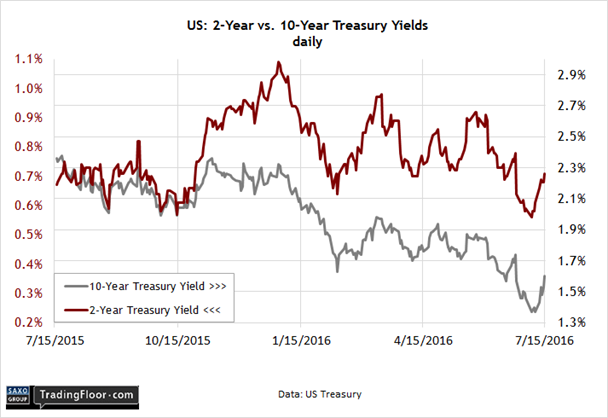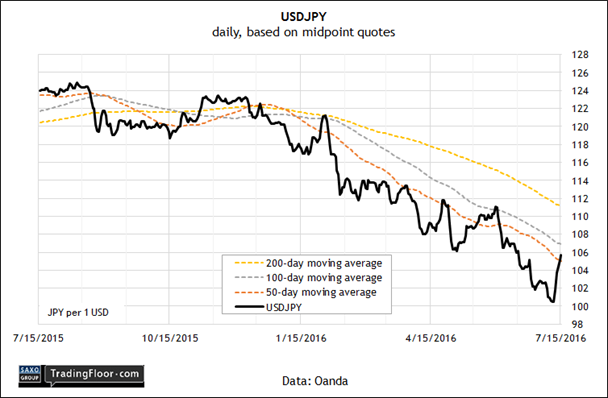- Economists project US Housing Market Index will rise to six-month high in July
- Will the 2-year Treasury yield’s rebound on Friday roll on this week?
- The yen’s rally stumbled last week amid a softer macro outlook for Japan
On a slow day for economic news, today’s monthly update of the US Housing Market Index will draw close attention in the wake of last week’s upbeat numbers for the world’s biggest economy. Meanwhile, keep your eye on the 2-year Treasury yield, which rebounded to a three-week high on Friday. USD/JPY will be topical as well after the yen’s rally this year made a sharp U-turn last week.
US: Housing Market Index (1400 GMT): Sentiment in the home-building industry is pointing to stable and perhaps modestly stronger growth for residential housing construction for this year's second half.
In last month’s update, the National Association of Home Builders' Housing Market Index ticked up to 60, a five-month high. The gain marked the first rise after HMI remained unchanged at 58 for four straight months.
“Builders in many markets across the nation are reporting higher traffic and more committed buyers at their job sites,” said NAHB’s chairman.
Economists are expecting HMI to tick up again to 61 for July, which would mark the highest reading since January, based on Econoday.com’s consensus forecast. If the prediction holds, the news will cast a positive light on tomorrow’s monthly report on new housing starts.

US: 2-Year Treasury Yield: Interest rates have been on a wild ride lately. After dropping to a record low for some maturities on the yield curve in early July, the slide reversed last week as the US stock market made new highs as economic data delivered upbeat news.
By the end of last week, the rebound left the 2-year yield – considered the most-sensitive for rate expectations – at a three-week high. The bounce looks a bit odd when you consider that Friday’s inflation remained subdued for headline prices. The consumer price index climbed 1.0% in June from a year ago (before seasonal adjustment), unchanged from the previous release.
A 1.0% inflation rate is low by historical standards, suggesting that pricing pressure remains weak and thereby giving the Federal Reserve more leeway to delay an interest-rate hike.
The core rate of inflation, however, points to a firmer trend. CPI ex-food and energy inched up to a 2.3% year-over-year pace – a four-month high and close to the strongest pace in four years. Since core CPI is considered a leading indicator for the headline data, the numbers suggest that the inflation trend is set to firm in the second half of this year.
Nonetheless, some analysts aren’t convinced. “What the inflation market is currently pricing is an incredibly benign inflation trajectory in the next 10 to 20 years,” advised Martin Hegarty, head of inflation-linked bond portfolio at BlackRock in New York, via Reuters late last week. “We are pricing a run rate that implies the Fed will miss its inflation target for a very, very long time and not only a miss but miss by a very wide margin.”
The Treasury market doesn’t necessarily disagree, although it’ll be interesting to see if yields will continue to bounce higher.
Meanwhile, the Fed funds futures market at last week's close continued to price in low odds –roughly 1% – for a rate hike at next week’s Federal Open Market Committee meeting, according to CME data. If that’s due to change, an early clue will be a 2-year yield that continues to rise in the days ahead.

USD/JPY: The Japanese yen hit a wall last week. After a strong rally in the first half of 2016, the currency tumbled after a change in sentiment shifted expectations in favour of expecting a new stimulus program from the Bank of Japan.
Economic data last week added to the yen’s weakness from the perspective of the greenback. Japan’s industrial output slumped a hefty 2.6% in June, in sharp contrast with the 0.6% sure for US production – news that contributed to a bearish view of the yen vis-à-vis the US dollar.
Sentiment data for Japan is sliding too. Last week’s update of the Markit Business Outlook survey, which focuses on the year ahead, declined to the lowest level since late 2012.
As a result, USD/JPY rebounded sharply last week, rising above its 50-day moving average for the first time since in more than a month, based on daily data. If the momentum endures in the days ahead and USD/JPY pushes above its 100-day average, the outlook for the yen may deteriorate further.
But late last week, government and central bank sources downplayed the prospects for “helicopter money”, a reference to a dramatic acceleration in monetary stimulus that some analysts are expecting. “Adopting helicopter money in the strict sense is impossible as it's prohibited by law,” said an official via Retuers. “If it's about the BoJ buying huge amounts of bonds and the government deploying fiscal stimulus, we’re already doing that.”
The comments helped the yen claw back some of the losses on Friday. But disappointing economic numbers in the weeks ahead could revive the bearish bias for the yen. Key numbers to watch this week include Thursday’s release of the All Industry Index for May and the flash July data for the Japan Manufacturing PMI on Friday.

Disclosure: Originally published at Saxo Bank TradingFloor.com
